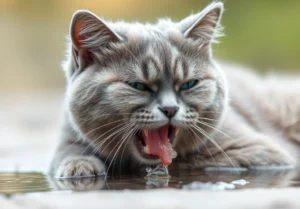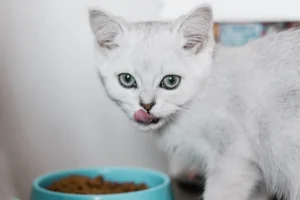Is your feline friend guzzling more water than usual? It’s normal to be concerned when you notice a spike in your cats’ water consumption. But fear not, there are a few reasons why your furry companions may be hitting the water dish more frequently than usual.
Possible Reasons for Increased Water Consumption
If you’ve noticed that your cats are drinking a lot more water than usual, there could be several reasons behind this behavior. One common cause could be a change in their diet. Perhaps you’ve recently switched to dry food, which may require them to drink more water to stay hydrated. Another possibility is health issues such as diabetes or kidney disease, which can lead to increased thirst in cats. Environmental factors like warmer weather or a hotter home can also play a role in prompting your feline friends to drink more water.
Understanding the reasons behind their increased water consumption is crucial in addressing any underlying issues that may need to be addressed. If you suspect that there may be a health concern at play, it’s best to consult with your veterinarian for further evaluation and guidance.
Signs of Dehydration in Cats
Keeping an eye out for signs of dehydration in your cats is essential to ensure they stay healthy and hydrated. One of the most common indicators is dry gums, which can be a sign that your cats are not getting enough water. Sunken eyes and lethargy are also red flags that your furry companions may be experiencing dehydration.
If you notice any of these symptoms in your cats, it’s important to take prompt action to ensure they receive the necessary care and hydration they need. Encouraging them to drink more water or offering wet food can help address mild cases of dehydration, but severe cases may require a visit to the vet for proper treatment.
Understanding Your Cats’ Kidneys
Have you ever wondered why your cats seem to be guzzling down water like it’s going out of style? Well, let’s talk kidneys. Cats’ kidneys are like tiny filtration plants in their bodies, responsible for balancing fluids and electrolytes. When your furry friends are drinking more water, it could be a sign that their kidneys are working overtime to maintain this delicate balance.
In some cases, increased water intake could be due to underlying health issues like kidney disease or diabetes. These conditions can cause your cats to feel constantly thirsty, leading them to seek out more water to compensate. If you notice a sudden spike in your cats’ water consumption, it might be a good idea to consult your vet for a check-up.
Tips for Encouraging Hydration in Cats
Encouraging your cats to stay hydrated is crucial for their overall well-being. Here are some tips to make sure your feline friends are getting enough water:
- Provide fresh water: Make sure your cats always have access to clean, fresh water. Cats are more likely to drink water that tastes clean and doesn’t have any strange odors.
- Incorporate wet food: Wet food contains more moisture than dry kibble, helping to increase your cats’ overall water intake. Consider adding some wet food to their diet to keep them hydrated.
- Use pet fountains: Cats are naturally attracted to running water. Investing in a pet fountain can entice your cats to drink more water throughout the day.
Remember, keeping your cats hydrated is key to maintaining their health and happiness. Don’t forget to pay attention to any changes in their water intake and consult your vet if you have any concerns.
Health Conditions That Can Cause Increased Thirst
If you’ve noticed your cats drinking more water than usual, it could be a sign of an underlying health issue. Common conditions that can cause increased thirst in cats include diabetes, kidney disease, and hyperthyroidism. These conditions can affect your cats’ kidneys and hormone levels, leading to excessive thirst. If you suspect any of these conditions, it’s essential to consult your veterinarian for proper diagnosis and treatment.
Monitoring Your Cats’ Water Intake
Keeping an eye on your cats’ water intake is crucial in detecting any changes in their drinking habits. By tracking how much water they consume daily, you can identify any sudden increases that may indicate a health problem. Ensure your cats have access to fresh water at all times and observe if they are drinking more than usual. Remember, early detection is key in providing timely care for your furry companions.
- Create a Water Log: Keep a record of how much water your cats drink each day. Note any deviations from their typical intake.
- Observe Behavior Changes: Watch for changes in your cats’ behavior, such as drinking from unusual places or frequent trips to the water bowl.
- Consult Your Vet: If you notice significant changes in your cats’ water consumption, consult your veterinarian for further evaluation.
Stay vigilant and proactive in monitoring your cats’ water intake to ensure their well-being and catch any potential health concerns early. Remember, your furry friends rely on you to keep them healthy and hydrated.
Importance of Regular Vet Check-ups
Regular veterinary check-ups are crucial in monitoring your cats’ overall health, including their water consumption. If you notice your feline friends drinking more water than usual, it could be a sign of an underlying health issue such as diabetes, kidney disease, or hyperthyroidism. By scheduling routine appointments with your vet, you can catch any potential problems early on and ensure your cats receive the necessary care and treatment.
Fun Cat Facts about Hydration
Did you know that cats are obligate carnivores, meaning they rely solely on meat for their diet? This diet can lead to lower water intake compared to omnivores, making hydration especially important for our feline companions. Cats have a low thirst drive, so they may not always drink enough water to stay properly hydrated. Offering wet food or a running water fountain can help encourage them to drink more. Additionally, cats have a highly efficient urinary system, concentrating their urine to conserve water. Keep those water bowls filled, folks!
- Cats have a unique way of showing love through licking their human’s skin. This grooming behavior dates back to when they were kittens with their mothers, mimicking being cleaned by her. So, if your cat licks you, it’s their way of showing affection.
- There are about 25 bones in a cat’s tail, which plays a crucial role in maintaining their balance while climbing or jumping. Amazing, isn’t it?
- Cats are crepuscular animals, meaning they are most active during dawn and dusk. So if your cat is zooming around the house at odd hours, it’s just their natural clock ticking!
Remember, staying hydrated is essential for your furry friends’ overall well-being. If you notice any changes in their water consumption or behavior, don’t hesitate to consult your vet for further guidance.
Alex, a passionate animal lover, has experience in training and understanding animal behavior. As a proud pet parent to two dogs and three cats, he founded AnimalReport.net to share insights from animal experts and expand his knowledge of the animal kingdom.




